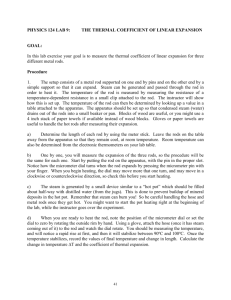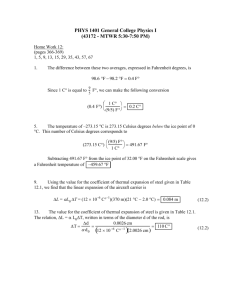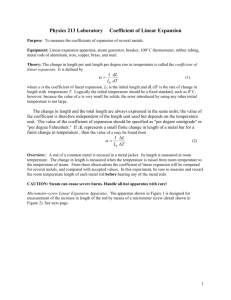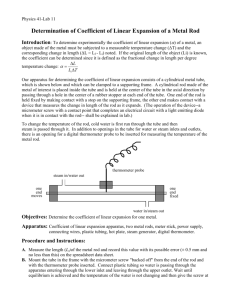7.1 EXPERIMENT #7 Linear Expansion of Solids Most materials
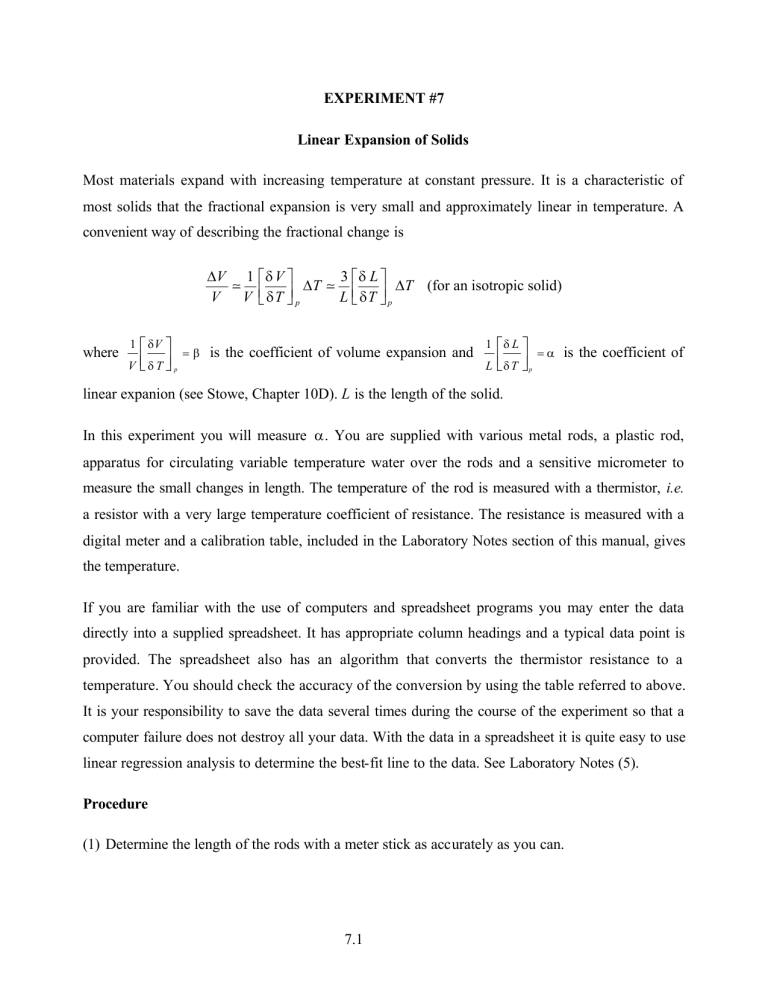
EXPERIMENT #7
Linear Expansion of Solids
Most materials expand with increasing temperature at constant pressure. It is a characteristic of most solids that the fractional expansion is very small and approximately linear in temperature. A convenient way of describing the fractional change is
∆
V
V
;
V
1
δ
δ
V
T
p
∆
T
;
3
L
δ
δ
L
T
p
∆
T (for an isotropic solid) where
1
V
δ
δ
V
T
p
= β is the coefficient of volume expansion and
1
L
δ
δ
L
T
p
= α is the coefficient of linear expanion (see Stowe, Chapter 10D). L is the length of the solid.
In this experiment you will measure
α
. You are supplied with various metal rods, a plastic rod, apparatus for circulating variable temperature water over the rods and a sensitive micrometer to measure the small changes in length. The temperature of the rod is measured with a thermistor, i.e.
a resistor with a very large temperature coefficient of resistance. The resistance is measured with a digital meter and a calibration table, included in the Laboratory Notes section of this manual, gives the temperature.
If you are familiar with the use of computers and spreadsheet programs you may enter the data directly into a supplied spreadsheet. It has appropriate column headings and a typical data point is provided. The spreadsheet also has an algorithm that converts the thermistor resistance to a temperature. You should check the accuracy of the conversion by using the table referred to above.
It is your responsibility to save the data several times during the course of the experiment so that a computer failure does not destroy all your data. With the data in a spreadsheet it is quite easy to use linear regression analysis to determine the best-fit line to the data. See Laboratory Notes (5).
Procedure
(1) Determine the length of the rods with a meter stick as accurately as you can.
7.1
(2) Mount a metal rod in the cylindrical water bath making sure that the bottom of the rod rests securely on the glass plug and not on the rubber stopper. Make sure the micrometer is in contact with the rod and that it moves freely.
(3) Study the water circulation system and make sure you understand the functions of the valves and all the tubing. Be careful, spills will take you a long time to clean up.
(4) Circulate room temperature water over the rod and check that the thermistor indicates a reasonable temperature.
(5) Plug in the water heater and as the temperature of the circulating water slowly increases record
∆
L , i.e.
the micrometer reading, and the temperature every few degrees. Unplug the heater, discard the hot water, mount a different rod, refill with cold water and repeat. Obtain a complete set of data for at least three different rods.
(6) Plot your data for each rod, and determine
α
. Compare your results with accepted values.
Fig. 1 Schematic of Apparatus.
7.2

